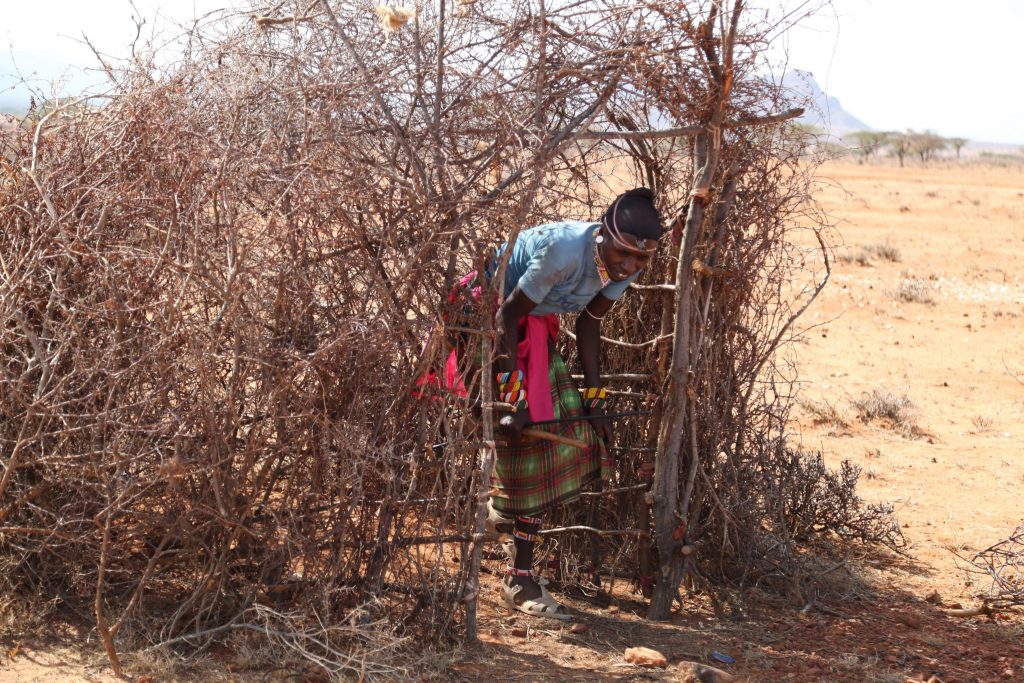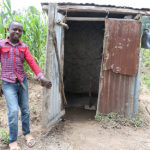In this picturesque land that can easily pass for an open-air theatre ideal for filmmaking, lack of sufficient toilets could be a setback. For quite some time, most inhabitants of the manyattas straddling the expanse in Samburu County have hardly been familiar with the risks associated with lack of pit latrines.
The bleak realities of the ravages that ensue as a result of poor sanitation are slowly striking some residents in the rural areas of this sprawling land. Jubilation songs now mark a new dawn for a number of communities.
There are 54 households at the Manyatta in Naamunyak. Each household has an average of five people. Here, a Community Health Volunteer (CHV), Julius Lesanjiir, is considered a Nkaing’oni (hero) in this land where Nkaing’onisho (heroism) is treasured. He’s in charge of 33 households. Nkaing’onisho is a concept which taps into the willingness of members of the communities in Samburu County to stand out as defenders. But, with a twist, a Nkaing’oni is not just a warrior who fights outsiders and keeps the herds safe – he also knows that there are also many threats within the community that can afflict a family’s health. This fits with the slogan ‘Ushujaa ni kulinda afya ya jamii’ (heroism is protecting the family’s health). This is a concept that is being promoted by Centre for Behaviour Change and Communication, through the USAID-funded Afya Timiza Project where WASH is one of the project’s components.

Because Lesanjiir is a Nkaing’oni, he understands too well that lack of toilets is a big threat to family’s health. He has taken it upon himself, alongside other men that he’s mobilized, to chip out soils on the peripheries of their manyatta, paving way for pit latrines.
“We’ve completed 16 toilets so far,” he says. This work began in March 2018. Lesanjiir hopes to have adequate pit latrines to serve the close to 300 people.
His efforts are bearing fruit. “The number of children who’ve been suffering from diarrhea has reduced.”
Most manyattas in the county barely have any latrines. Open defecation is still practiced. Fears abound that water-borne diseases could affect scores of households. However, this trend is slowly changing.
Any taboo-related reservations of sharing latrines with relatives are allayed. A village elder at the manyatta in Naamunyak, Lmankarian Lesirko, rallies support for what the young moran, Lesanjiir is doing.
“Everyone in this manyatta is using these toilets,” he says, adding, “You’ll not find human waste around.” He pledges, “We’ll put up even more.”
Lesanjiir’s method is rather rudimentary. This reflects that he’s doing what it takes to keep some illnesses allied to poor sanitation standards at bay. “We do not have jembes,” he regrets. But that is no impediment. “ So we use our pangas to dig.” They also have no spades to shovel out freshly dug out soil. Whatever improvised implement they lay their hands on, is precious. They need toilets, and urgently so. Lesanjiir and his companions keep making endless trips to nearby shrubbery to lop off branches to be used as ‘wall’ and ‘roofing’ material. Some of the shrubs and twigs are thorny.
Lentenai village, close to Wamba, is another site where men have come to terms with the high price they may pay if they do not embrace the construction of latrines. Here, another CHV, Ivan Lekutano, is working side-by-side with other men for the same course that Lesanjiir is pursuing in Naamunyak.
Where there are no latrines, embarrassing situations are unavoidable. For instance, where would visitors relieve themselves when need arises? In the bushes, if at all any!
“When people go to bushes for calls, the water in wells and rivers becomes contaminated,” explains Lekutano. “That makes it unsafe for drinking, and for other domestic uses.”
The progress he’s made has not been smooth sailing. “At the beginning, people were really resistant,” he recollects. “I persisted and now they have understood the importance of having toilets.”
In this land where heroism is treasured, Lekutano and his peers are aware that their heroism could as well come via another route. The putting up of toilets for their manyatta could make them earn it.
Lekutano sensitizes his fellow elders on the importance of toilets in their community. Sometimes they work until nightfall. “We’ve constructed 42 toilets around here,” he states.
Unlike the sites at the manyattas in Naamunyak and Lentenai where only men are involved, men and women are working together as elation songs rend the air at one location in Wamba town. This group at Mataakwani has been doing it on a revolving manner. A latrine is being brought up for a group member who is physically challenged.

The chairman of the group, Jonah Lolng’ojine, says. “We have seven villages around this area where we have been educating residents on the importance of adhering to a high level of hygiene.”
The many cases of preventable illnesses are of concern to the Medical Superintendent of Maralal Referral Hospital, Dr Robert Nato. “We receive very many cases of diarrhea,” he says. “This is as a result of poor health seeking behaviour, which begins at home.”
Many diseases are as a result of, “Lack of clean water and environment coupled with ignorance on the part of parents on how to prevent them.”
Public Health Officer based at Wamba Health Centre, Christopher Lekaitik, admits that poor sanitation posses a threat to residents. “Homes need to have a container of water to clean hands with soap, after visiting a toilet.”
A few homes have improvised a way of doing what Lekaitik says; having a Jeri can at an elevated position with a rope fastened around its nozzle, dropping to a plant of wood placed at an angle on the ground. Stepping on the piece of wood tilts the can making water flow out.

The excavation of pit latrines is one of the preventive measures that could be taken to keep some illnesses in check. Dr. Nato points out that the Rotavirus is the most known factor responsible for diarrhea in under-five. “If all children get the correct immunization schedule until the age of two, then we’re sure that at the end, we’ll minimize some of those diseases including diarrhea for we have a vaccine against the Rotavirus.”
Lesanjiir and Lekutano are just a few of the CHVs playing a central role in effecting a turn around in the disposal of faecal matter in their county by increasing toilet cover. Outreach programmes conducted in most remote areas in the county under the Afya Timiza project has seen masses embrace the desired willingness to change their attitudes.
Afya Timiza is one of the projects being implemented by the Centre for Behaviour Change and Communication (CBCC). The target counties are Samburu and Turkana, where it seeks to sensitize communities on utilization of quality Family Planning and Reproductive, Maternal, New-born, Child and Adolescent Health, Nutrition and Water, Sanitation and Hygiene (WASH).
The project covers a five-year period, from September 2016 to September 2021. Sanitation experts will be looking for the real picture of the progress that will have been made when the project concludes.



